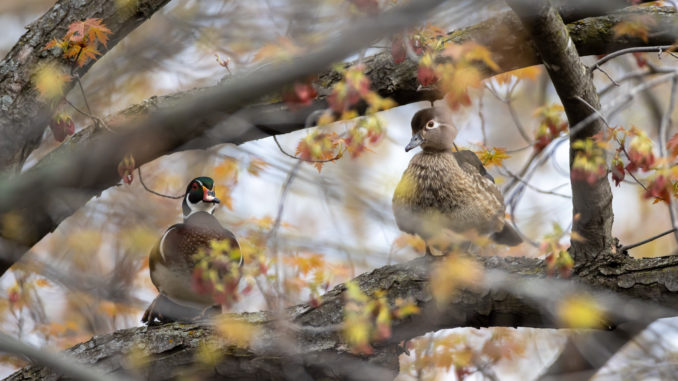
Spring is a wonderful time of year. Especially right after the thick ice of winter melts off the ponds and small lakes. And just like magic as soon as the water is open, the ducks show up. For me, the first ducks of spring are the Wood Ducks (Aix sponsa).
Depending upon where you live, they are sometimes called Carolina Duck. But the name Wood Duck is generally the accepted common name. The name “Wood” comes from the fact they inhabit wooded areas with ponds or lakes nearby. You see they are a duck that nests in trees. That’s right, a duck that nests in trees.
Seeing these ducks climbing around the branches of a big oak or maple tree always takes some adjustment in your ideas about ducks. When you think of ducks you think swimming in water. But the Wood Duck spends a lot of time each spring walking around the branches of large mature trees. The females are seeking out suitable natural cavities to nest.
This spring I have spent a lot of time in the woods, sitting along the edge of a small pond studying and capturing images and video of these amazing ducks. Each day I would wake extra early and gather up everything needed for the morning shoot. This includes a ground chair, camouflage cover-up, camera, tripod, food and water. Hiking in the early morning twilight, on a cool spring morning is magical. Since I will be sitting right on the edge of the pond, I wear tall waterproof boots and rain pants in addition to several layers of jackets to say warm.
The trick is to sneak into the edge of the pond without being detected by the ducks who are just waking up. My ground chair has no legs, so I sit directly on the ground. My feet sit in three to four inches of water. Everything is covered in camouflage fabric, so my human form is not discernible. Then I sit and wait. On any given morning I will sit for three of four hours so something to eat and drink really helps.
As the light comes up, it reveals the natural beauty of a small woodland pond, surrounded by tall oak and maple trees. The pond isn’t more than 12 inches deep and often goes dry when summer arrives. But it is perfect for the Wood Ducks in the spring.
Found only in North America, the Wood Duck is a medium sized duck. They are larger than any of the teal species but smaller than the familiar Mallard. The adult male Wood Duck is by far the most colorful and ornamented duck in North America. His beaty is unmatched in the waterfowl word. The males have beautiful iridescent plumage with a green head and long flare of feathers on the back of its head. But what really stands out to me as a photographer / videographer is the blood red eyes. Even the ring around the eye and the eyelid is red.
The females are dull brown with a distinctive white eye-ring. And, like most duck species, the female is the more vocal of the two. While the male gives a distinctive call, it’s the female that talks the most.
Nesting is often near water but surprisingly they can nest upwards of a mile away from any body of water. In spring the females actively compete for natural nesting cavities in tall mature trees. The good news is, the Wood Duck takes very well to human-made nest boxes. The important thing to remember if you are going to put up a Wood Duck box is to do it the right way and mount it on a post or pole and make sure you put on a predator guard. Don’t just nail a nest box to a tree and call it done, because all you did was provide a new place for squirrels to nest and nothing for the Wood Ducks.
Sitting at the edge of the pond and watching the sun come up, the first Wood Ducks start to swim around. Usually, the males are following the females no matter where she goes. Suddenly a pair of Wood Ducks fly into the pond area. They fly a tight circle above the pond while the female is calling. Then both ducks land in the branches high up in a big maple tree.
This is always a fun and fascinating part of the Wood Ducks life. The tree life. I slowly turn my camera and capture the image. Each time I see this I am humbled by the magnificent diversity of nature, even if it’s just a duck walking around on tree branches. Until next time…
Stan Tekiela is an author / naturalist and wildlife photographer who travels the U.S. to study and capture images and video of wildlife. He can be followed on facebook.com, twitter.com and Instagram.com. He can be contacted via his web page at naturesmart.com.
